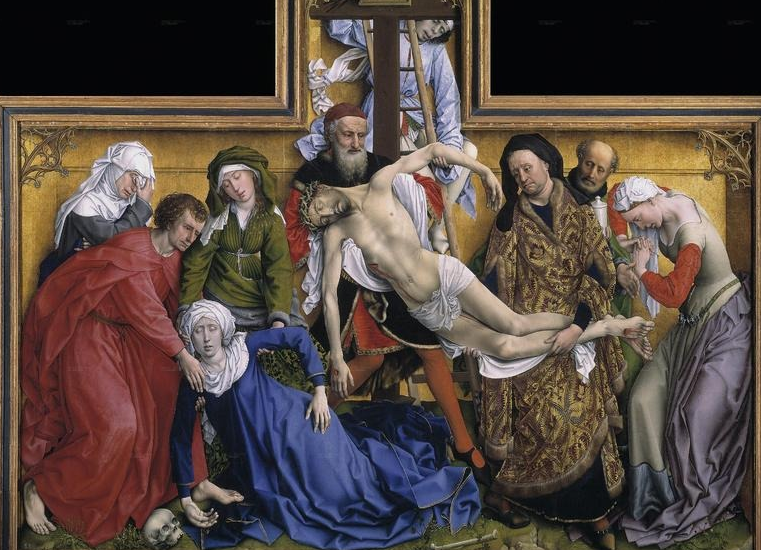文藝復(fù)興時期的羅馬
spiritual pursuits
精神追求
were not always the first calling of princes of the church
并不總是教會領(lǐng)袖的要務(wù)
who frequently lived in opulent splendor
他們通常生活鋪張奢華
rivaling or surpassing that of secular rulers or princes
地位甚至超過世俗統(tǒng)治者或王族
moreover we should also keep in mind
此外,我們必須記住
that the decorations of this private space
這類私人空間的裝潢
were accessible only to a restricted audience
只有限定的人物能夠享受

in the same manner that a mistress portrait or an erotic drawing
同樣地,一幅情婦的畫像,或春宮圖
where intended for private consumption
也只限于私人觀摩
rather than public display
并不對公眾展示
and finally the dichotomy between sacred and erotic
最終 16世紀(jì)上半葉
was not as pronounced in the first half of the sixteenth century
神圣與情色之間的界限
as it would come to be following the implementation in Rome
并不像日后羅馬天特會議法令實施后
of the decrees of the Council of Trent
那么明顯
a series of reforms of the Catholic church intended to
作為對北方新教發(fā)起的破壞性攻擊的回應(yīng)
respond to the damaging assaults launched by Protestants in the north
羅馬天特會議對天主教會進(jìn)行了一系列的改革
indeed the sacred and the profane were often a seamless continuum
的確16世紀(jì)前期,神圣和世俗兩個領(lǐng)域
in Rome in the early decades of the sixteenth century
的確是渾然一體的
visual testimony of this exists in the rather
藝術(shù)家們筆下風(fēng)格混雜的
incongruously erotic and sensual religious images
同時含有色情,世俗和宗教因素的畫作
produced by artists
就是最好的證明
who had experienced the licentious and libertine culture
這些人體驗過16世紀(jì)20年代
of Rome in the 1520s
羅馬放蕩不羈的文化
works like Parmigianino's Madonna de la Rosa on the left
如左邊這幅是帕爾米賈尼諾畫的《玫瑰圣母》
and Rosso Fiorentino's “Dead Christ”
右邊是羅梭·費奧倫提諾的《死去的基督》
with angels on the right
右邊伺立著天使
mistresses, courtesans, and prostitutes
情婦,交際花和妓女
nebulous and often interchangeable categories
這幾個范疇模糊不清,通常可相互轉(zhuǎn)換
figure prominently in the profane culture
也大量地出現(xiàn)在
of Renaissance Rome
文藝復(fù)興時期的世俗文化中
the literary paradigm is Pietro Aretino's Nana
文學(xué)的典型案例就是阿雷蒂諾筆下的娜娜
the worldly wise “puttana” or whore
娜娜是位世故聰明的puttana(意語:娼妓)
who has seen, heard, and done it all
見多識廣,博聞強記
in her conversations with her daughter Pippa
娜娜想將女兒佩帕訓(xùn)練成一位誠實的交際花
who she is training to be an honest courtesan
在跟女兒佩帕的談話中
Nana herself distinguishes between these categories
娜娜給這三種范疇作了區(qū)分
and advises how the enterprising Pepa
并告誡有進(jìn)取心的佩帕
And other practitioners can move up through the ranks
這個行業(yè)里應(yīng)該如何一步步升上去
to transform themselves from a puttana to a cortigiano
從娼妓晉升到交際花的地位
this portrait of a nude woman by Raphael known as the fornirina
這是拉斐爾作的一幅裸女畫像
almost certainly represents the artist's mistress
幾乎可以肯定是這位藝術(shù)家的情人
the fact that Raphael was betrothed to
事實上,拉斐爾同當(dāng)時很有權(quán)勢的
the niece of the powerful Cardinal Bibbiena
比比安那紅衣主教的侄女訂婚了
patron of the stufetta we looked at a moment ago
這位主教就是我們剛剛提到過的私人浴室的主人
was apparently of little concern to him
但很顯然拉斐爾并不在意
and he deftly managed to allude the bonds of matrimony
他巧妙地逃開了婚姻的束縛
in order to engage in non-conjugal liaisons
以方便進(jìn)行這段婚外戀情
as many scholars have observed
許多學(xué)者注意到
Raphael signaled his proprietary ownership over the woman
拉斐爾在這位女子的手環(huán)上簽上了自己的名字
by inscribing his name prominently on her armband
以宣告對她的所有權(quán)
a shutter that once concealed the painting
以前這幅圖之前擋有擋板
but all from its intended audience
以阻隔除了特定對象之外其他人的視線
was a measure of its private and therefore implicitly erotic nature
保護(hù)了隱私,也保護(hù)了其暗含的情色本質(zhì)
such concealment
這種藏掖
was a convention in the display of mistress portraits
是展示情婦畫像的一種傳統(tǒng)



